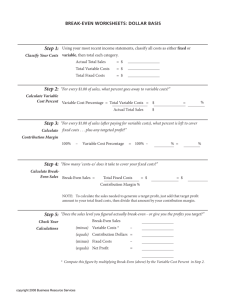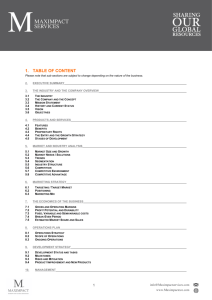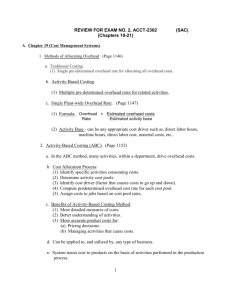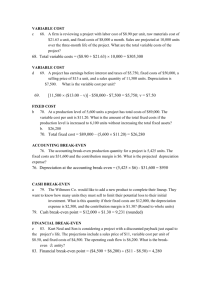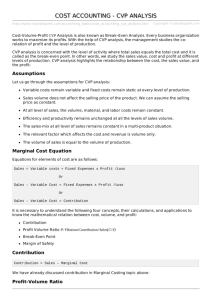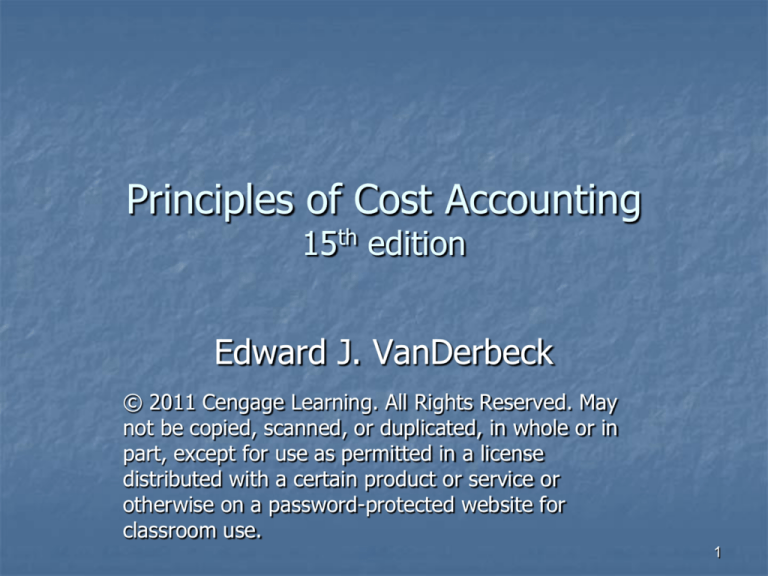
Principles of Cost Accounting
15th edition
Edward J. VanDerbeck
© 2011 Cengage Learning. All Rights Reserved. May
not be copied, scanned, or duplicated, in whole or in
part, except for use as permitted in a license
distributed with a certain product or service or
otherwise on a password-protected website for
classroom use.
1
Chapter 10
Cost Analysis for Management
Decision Making
2
Learning Objectives
LO1 Compute net income under variable
and absorption costing.
LO2 Discuss the merits and limitations of
variable costing.
LO3 Define segment profitability and
distinguish between direct and indirect
costs.
3
Learning Objectives (cont.)
LO4 Compute the break-even point and the
target volume needed to earn a certain
profit.
LO5 Calculate the contribution margin ratio
and the margin of safety ratio.
LO6 Discuss the impact of income tax on
break-even computations.
4
Learning Objectives (cont.)
LO7 Use differential analysis to make
special decisions.
LO8 Identify techniques for analyzing and
controlling distribution costs.
5
Variable Costing
(also known as Direct Costing)
The cost of manufacturing a product includes
only variable manufacturing costs.
Fixed factory overhead is classified as a
period cost and is expensed on each month’s
income statement.
The difference between sales and all variable
costs is termed contribution margin.
6
Variable Costing (cont.)
Direct Material
Direct Labor
Variable Manufacturing OH
Fixed Manufacturing OH
Selling Costs
Administrative Costs
Product Costs
Inventory Accounts
on Balance Sheet
Cost of Goods Sold When
Finished Goods are Sold
Period Costs
Expense Accounts on
Income Statement
7
Absorption Costing
(also known as Full Costing)
Assigns both fixed and variable
manufacturing costs to the product.
Absorption method will report a higher cost
of goods sold due to the inclusion of the fixed
factory overhead.
The difference between sales revenue and
cost of goods sold is termed gross margin.
8
Absorption Costing (cont.)
Direct Material
Direct Labor
Variable Manufacturing OH
Fixed Manufacturing OH
Selling Costs
Administrative Costs
Product Costs
Inventory Accounts
on Balance Sheet
Period Costs
Cost of Goods Sold
when Finished Goods
are Sold
Expense Accounts on
Income Statement
9
Merits and Limitations of
Variable Costing
This method highlights the relationship between
sales and all variable costs.
May be easier for members of management who are
not formally trained in accounting.
Variable costing is not a generally accepted method
of inventory costing for external purposes because
total costs are not matched with sales revenue and
does not include fixed factory overhead in the work
in process and finished goods inventories.
10
Segment Reporting for
Profitability Analysis
A segment of a company may be a
division, a product line, a sales territory,
or another identifiable unit.
This analysis requires that all costs be
classified into one of two categories:
Direct costs – can be traced to the segment
being analyzed.
Indirect costs – cannot be identified directly
with a specific segment.
11
Segment Reporting for
Profitability Analysis (cont.)
A company’s segment report isolates
costs, variable and fixed, that can be
directly traced to the segments.
Costs may be direct costs in one segment
and indirect costs in another segment.
12
Cost-Volume-Profit (CVP)
Analysis
Technique that uses the degrees of cost
variability for measuring the effect of
changes in volume on resulting profits.
It is assumed that fixed costs will remain
the same in total within a range of
production volume in which the firm
expects to operate, known as the relevant
range.
13
Limitations of CVP Analysis
CVP analysis assumes that all factors except
volume will remain constant for a given period of
time.
In some cases, costs are relatively unpredictable
except over very limited ranges of activity.
Anticipated results depend on the stability of the
CVP relationships as they have been established.
14
Break-Even Analysis
The break-even point is the point at which
sales revenue covers all costs to
manufacture and sell the product, but
there is no profit.
Costs must be segregated according to
their degree of variability.
15
Break-Even Point Calculations
Sales revenue (to break even) =
Cost to manufacture +
Selling and administrative costs
Sales revenue (to break even) =
Fixed manufacturing and selling and administrative costs +
Variable manufacturing and selling and administrative costs
16
Break-Even Point Calculations
(cont.)
Break-even sales volume (dollars) =
Total fixed costs / Contribution margin ratio
Break-even sales volume (dollars) =
Total fixed costs / 1 – (Variable costs/Sales revenue)
Break-even sales volume (units) =
Total fixed cost / Unit contribution margin
17
Margin of Safety
Indicates the amount that sales can
decrease before the company will suffer a
loss.
Margin of safety (dollars) =
Sales revenue – Break-even sales revenue
Margin of safety ratio =
Margin of safety / Sales
18
Effect of Income Tax on
Break-Even Point and Net Income
Pre-tax income =
After-tax income / 1 – Tax rate
Target volume (units) =
{Fixed costs + [Target after-tax income / (1 – Tax rate)] } /
Unit contribution margin
Target volume (dollars) =
{Fixed costs + [Target after-tax income / (1 – Tax rate)] } /
Contribution margin ratio
19
Differential Analysis
Differential analysis is a study that highlights the
significant cost and revenue data alternatives.
The designated purpose for which a cost measurement
is to be made should be included in the cost analysis.
Where there is excess capacity, only the differential
costs per unit should be considered in producing
additional units.
Generally, differential costs do not include fixed factory
overhead costs.
May be used in make or buy decisions.
20
Accept or Reject a Special Order
Many companies follow a practice of
contribution pricing, meaning accepting a
selling price as long as it exceeds variable
cost, thus contributing some positive
contribution margin in times of excess
capacity.
21
Make or Buy
Unused plant capacity might be utilized to
manufacture a finished part that was
purchased in the past.
This analysis will determine the savings
that may be realized.
22
Distribution Costs
Efficient control of all costs should cover
distribution costs as well as production costs.
Distribution costs include the costs incurred to
sell and deliver the product.
Accountants must devote more time to the study
of distribution costs to answer questions
concerning the spreading of selling and
administrative expenses to each type of product
sold, sales offices, salespersons, and each
separate order.
23



